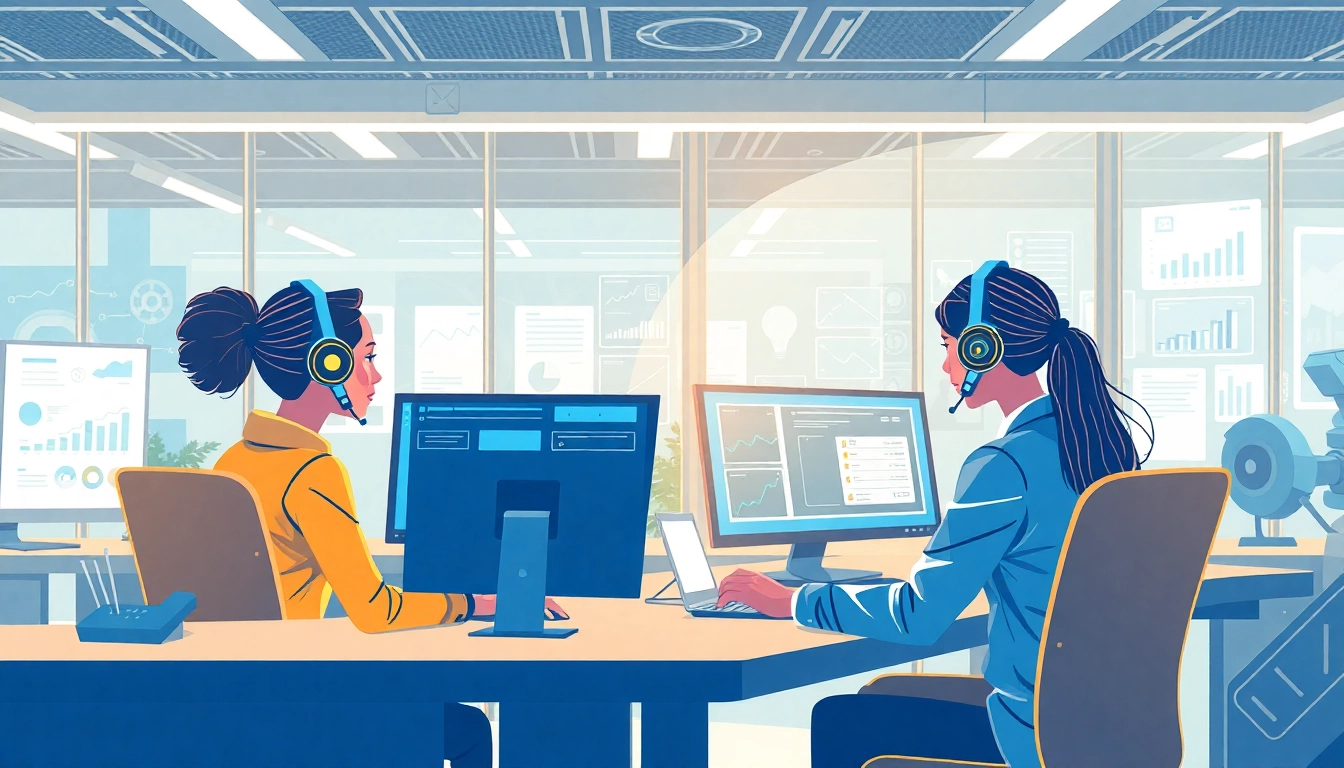Understanding AI Outreach Agents
In the rapidly evolving landscape of sales technology, AI outreach agents have emerged as essential tools for sales teams aiming to improve productivity and efficiency. These AI-driven tools assist sales representatives by automating various manual tasks, allowing them to focus on building meaningful relationships and closing deals. In a world where efficiency is paramount, understanding the role and functionality of AI outreach agents is crucial for any modern sales organization.
Definition and Role in Sales
AI outreach agents are sophisticated software applications designed to handle repetitive tasks traditionally managed by sales representatives. This includes everything from data entry to scheduling follow-ups. By automating these processes, AI outreach agents enable sales teams to work smarter rather than harder. Their primary function is to support sales professionals in their daily operations, streamlining workflows and increasing overall productivity.
Key Features of AI Outreach Agents
Some of the standout features of AI outreach agents include:
- Automation of Routine Tasks: They automate tasks like email follow-ups, meeting scheduling, and customer research.
- Data Analysis: Many AI outreach agents utilize machine learning to analyze data trends and provide actionable insights, enhancing decision-making.
- Personalization: AI can analyze customer preferences and behavior, allowing sales teams to tailor their communications effectively.
- Integration with CRM Systems: They often integrate seamlessly with existing CRM platforms to enhance workflow without disrupting established processes.
Benefits for Sales Teams
The implementation of AI outreach agents offers numerous benefits, including:
- Enhanced Productivity: By taking on mundane tasks, these agents allow sales reps to allocate their time to high-value activities such as client interactions.
- Improved Accuracy: They minimize human error in data handling, ensuring that customer information is accurate and up-to-date.
- Scalability: Businesses can scale their outreach efforts without a corresponding increase in personnel costs, making it easier to reach more potential clients.
- Cost Efficiency: With automation, companies can reduce operational costs associated with manual outreach efforts.
AI Outreach Agents vs. Traditional Methods
Efficiency Gains
One of the most significant advantages of AI outreach agents over traditional methods is the substantial increase in efficiency. Unlike manual outreach, which can be time-consuming and prone to error, AI outreach technologies operate at speeds and scales that humans simply cannot match. For instance, AI can send thousands of follow-up emails every day based on pre-set parameters and algorithms, ensuring timely engagement with prospects.
Automation of Repetitive Tasks
Sales professionals often spend a considerable amount of time on administrative duties, detracting from their core responsibilities of selling and relationship-building. AI outreach agents handle these repetitive tasks—such as scheduling meetings, entering data into CRMs, and generating reports—freeing up valuable time. This allows sales representatives to focus on more strategic activities that require human intuition and emotional intelligence.
Data-Driven Decision Making
AI outreach agents excel in analyzing vast amounts of data to generate insights that inform strategic decisions. Traditional methods often rely on intuition and past experiences; however, AI uses predictive analytics and business intelligence to determine customer preferences and behaviors. For example, AI can analyze which outreach methods yield the highest conversion rates, empowering sales teams to adjust their strategies accordingly.
Choosing the Right AI Outreach Agent
Factors to Consider
When selecting an AI outreach agent for your organization, several critical factors must be taken into account:
- Compatibility: Ensure the AI tool integrates seamlessly with existing CRM and sales platforms.
- Scalability: The agent should grow with your business, adapting to an increasing volume of outreach.
- Usability: Look for a solution that is user-friendly and requires minimal training for sales staff.
- Cost: Analyze whether the solution provides a good return on investment. Compare pricing models and scalability options.
Evaluating Different Platforms
It’s essential to evaluate multiple AI outreach platforms to identify the one best suited for your team’s needs. Take advantage of free trials and demos to assess user interfaces, capabilities, and overall performance. Consider factors such as:
- Real-time analytics and reporting capabilities
- Customization options for outreach programs
- Support and resources available for troubleshooting and optimization
User Testimonials and Case Studies
Researching user testimonials and case studies can offer valuable insights into the efficacy of different AI outreach agents. Look for reviews that highlight specific outcomes, such as increased open rates, improved conversion rates, or decreased time spent on administrative tasks. Direct feedback from users can help paint a clearer picture of how an AI outreach agent performs in real-world conditions.
Implementing AI Outreach Agents in Your Workflow
Integration Steps
Implementing an AI outreach agent involves a well-defined process that ensures smooth integration into existing workflows:
- Define Objectives: Clearly define what you want to achieve with the AI outreach agent.
- Select the Right Tool: Based on your earlier evaluations, choose the AI platform that best fits your needs.
- Set Up Integrations: Connect the AI agent with existing systems, such as your CRM or marketing automation tools.
- Train Your Team: Provide training sessions for your sales team to familiarize them with the new technology.
- Monitor Performance: Regularly review performance metrics to ensure the AI outreach agent meets your objectives.
Best Practices for Usage
To maximize the effectiveness of AI outreach agents, consider implementing the following best practices:
- Personalize Communications: Utilize the data available to create tailored outreach that resonates with potential customers.
- Automate Wisely: While automation is a fundamental benefit, maintain a balance with human interaction in your sales processes.
- Regularly Update Parameters: Continuously refine the AI agent’s algorithms and parameters to adapt to changing market dynamics or customer preferences.
- Encourage Feedback: Foster an environment where your sales team can provide feedback on the AI outreach tool’s performance and suggest improvements.
Measuring Success and ROI
To assess the success of your AI outreach agent, it’s vital to establish key performance indicators (KPIs) that reflect its impact. Important metrics may include:
- Response Rates: Measure how often recipients respond to outreach efforts.
- Conversion Rates: Track how many leads turn into customers as a direct result of the AI-driven outreach.
- Time Savings: Calculate the time saved by sales reps due to automation and focus on high-value activities.
- Revenue Growth: Analyze overall revenue growth and attribute a portion of that to improved outreach efforts.
The Future of AI in Sales Outreach
Emerging Trends
The field of AI in sales outreach is continually evolving, with several emerging trends poised to shape its future:
- Enhanced Personalization: Advances in AI and machine learning will allow for even greater personalization in outreach, anticipating customer needs and providing timely solutions.
- Voice and Video Integration: Expect to see a rise in the use of voice and video outreach, complementing traditional email campaigns.
- Predictive Analytics: Future AI tools will leverage predictive analytics to forecast trends more accurately, enabling proactive sales strategies.
Predictions for AI Outreach Agents
Looking ahead, we can predict that AI outreach agents will not only become more sophisticated but will also take on more strategic roles within sales departments. The convergence of AI with other technologies—such as big data, blockchain, and IoT—will further enhance their capabilities, making them indispensable assets in any sales arsenal.
How to Stay Ahead in a Changing Landscape
To remain competitive in the artificial intelligence domain, businesses should consider the following strategies:
- Continuous Learning: Encourage teams to stay informed about new AI trends and technologies, as the field is constantly changing.
- Invest in Training: Ensure that your sales staff is well-trained in utilizing AI tools effectively.
- Adaptability: Be prepared to pivot your strategies as new AI innovations emerge.



